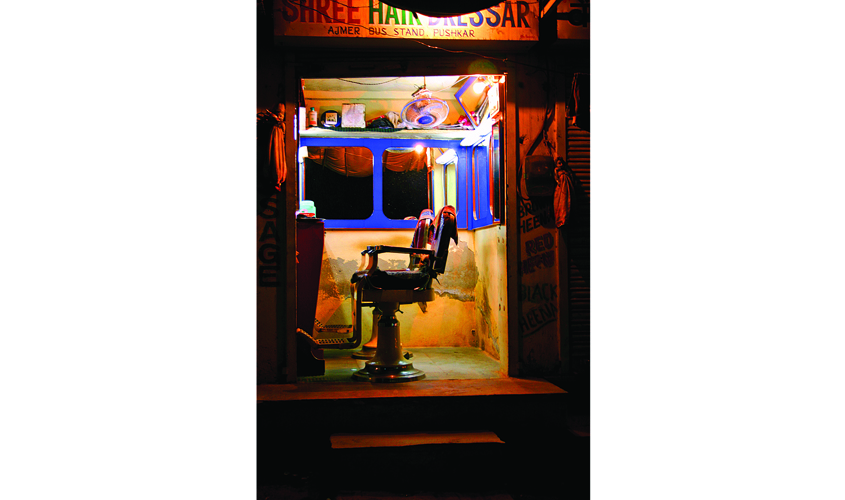A little bit of searching, or a good classic work of literature, would make you privy to the fact that barbers were the doctors of the Middle Ages — adept at fine tasks of primitive times like blood letting, amputating limbs and pulling out teeth — something that made them valuable at times of war. But as is the norm, adaptability is key and so it has been with barbers who, over time, have been refined into terms such as “hair dressers”. In European history as beards fell out of fashion barbers began to speacialise in attending to hair. But the question is: are barbers and hairstylists all the same? Or are these new professional tags differentiating embellishments of progressive times?
Within Delhi, the urban space, there is so much to gain from the panoramic expanse which is equally visible in the realm of barbers. They are evidently distinguishable simply by the physical traits of the establishments they work in. But once you take a seat and begin to observe what is available to the customer it is only then that this one large and crucial culture begins to divide itself profusely into sub-cultures, much like splitting amoeba cells. Ignoring the nitty-gritties of dexterous classification we could narrow the types to three specific sorts of sub-cultures in the profession.
Beginning like all scientific classification endeavors, we take the single-celled organism. This would be a barber that sits at a footpath, quintessentially outside a park or under a tree, which provides the natural coolant called shade. He has one wooden chair, in case he is enterprising enough then this chair might have cushions, a small mirror placed on the fence of the park or the tree and beside this mirror shall be the obvious tools of the trade. Teg Chand, 60 years of age, has been a barber outside a local park for the past 38 years. Teg Chand says, “The overall objective of the self is to earn and eat,” and emphatically states, “I am a barber by birth.” Seeing the prosaic setup one could not ignore the fact that this is a mobile shop which caters to “pedestrians that pass by and the poor”. Teg Chand, on an average day, attends to 30-40 customers and takes only Rs 20 for a haircut. His little shop has the advantage of a live-motion city view that surrounds you during the haircut and massage.
The final, young and most in-your-face form of the barber culture is visible in hairdressing salons. They are bright, exceptionally comforting, silent and offer all the necessary evils of luxury.
The second sort has been made symbolic in many forms of pop culture. Movies and American television shows like Black-ish dedicated segments to them. These are the barber shops you find down any busy street. These places are known for mirth and conversation. Gulfam Salmani, who works in one of these, says, “I started working as a barber at the age of 16 and now, if you notice, most barbers are young.” This is not a family business for them but a modest way to livelihood, and upon being asked how he learnt the trade, he says, “Like you learnt to write with a pen, I learnt this just by observing.” The poetic spirit never shies away in the city. The primary characteristic of such barber shops is the conversation which fills the place, and anything can serve for subject matter: gossip, politics, celebrities and “dirty laundry”. The primary theme is “laughter”, say all those who sit in the chairs. “Our aim is a happy customer; if they’re happy then we’re happy,” says Salmani. They are growing due to the population and competition which are heavily demanding. A haircut here would cost Rs 50.
The final, young and most in-your-face form of the barber culture is visible in hair dressing salons. They are bright, exceptionally comforting, silent and offer all the necessary evils of luxury. Affinity, Jawed Habib and Ambika Pillia etc. are just some of the numerous salon chains in Delhi. These salons cater to the upper and middle classes in terms of prices, each with a very specific set of aims that individualise them. Vishal Sharma, the Director of the Affinity chain of salons says, “Our focus is to educate our clients about hair care through our professional knowledge in a comfortable clean environment.” The meditative silence and the attention paid to the customer’s whimsical needs defines them characteristically. Upon enquiring on the credibility of the hands, Vishal Sharma remarks, “To beat the competition we give international trainings to our hairstylists. Its helps us know what we need to do to meet our clients’ needs.” It’s a matter of faith when it comes to placing your appearance in the hands of a stranger, and it is this discomfort that salons try to erase. They respond to the need of the moneyed class or perhaps just pamper them, but the point is that a veritable amount of specialisation has now been ventured into. A sharp cut costs around Rs 600. The advanced tools, the bizarrely specific products used and the focus to create an individual experience have transformed the culture into something new. Is this “hairstyling”?
Barbers or hairstylists, no matter what roots or what training, are all assimilated into the girdle of one culture: Barber-hood. They have attended to the superficial desires of our forefathers and they shall persist to do so for our children. Perhaps it is a profession in this era of specialisation, but let us not rule out the possibility that this culture might just be a form of art, for it is always an aesthetic pleasure to behold yourself beautified by the hands of another.

